The Friar and the Cipher

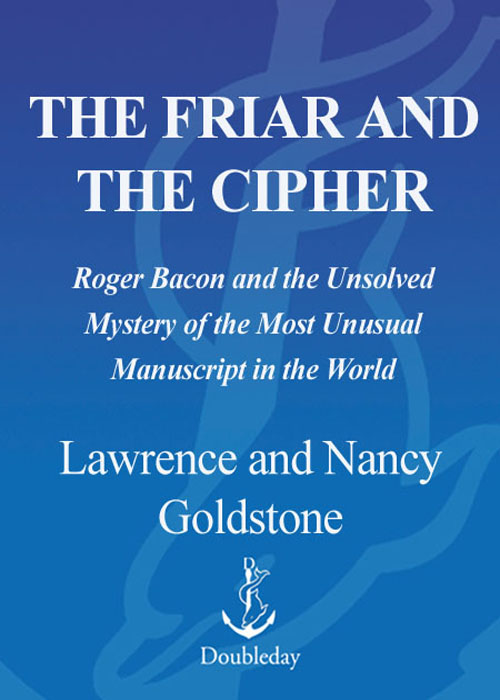
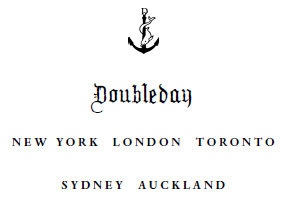
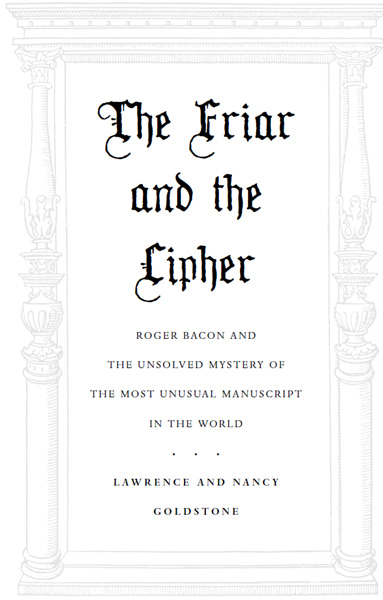
CONTENTS
• • •
CHAPTER ONE
Turmoil and Opportunity: Roger Bacon's England
CHAPTER TWO
Logic and Mysticism: Aristotle, Plato, and Christianity
CHAPTER THREE
Logic and Theology: The Evolution of Scholasticism
CHAPTER FOUR
Dogma, Drink, and Dissent: The University of Paris
CHAPTER FIVE
Rebels in Gray Robes: Oxford
CHAPTER SIX
Science Goes Mainstream: The Rise of Albertus Magnus
CHAPTER SEVEN
The Dumb Ox: Thomas Aquinas
CHAPTER EIGHT
The Miraculous Doctor: Roger Bacon at Oxford
CHAPTER NINE
Autocracy in the Order of St. Francis
CHAPTER TEN
Theology Becomes a Science: The Logic of Thomas Aquinas
CHAPTER TWELVE
Seeing the Future: The
Scientia Experimentalis
of Roger Bacon
CHAPTER THIRTEEN
Knowledge Suppressed: The Conservatives Respond
CHAPTER FOURTEEN
Enigmas and Espionage: The Strange Journey of Dr. Dee
CHAPTER FIFTEEN
Brilliant Braggart: Francis Bacon
CHAPTER SIXTEEN
The Trail of the Cipher Manuscript
CHAPTER SEVENTEEN
The Making of the Most Mysterious Manuscript in the World
CHAPTER NINETEEN
The Unfinished Legacy of Roger Bacon
Full-color Illustrations from the Voynich Manuscript
TO EMILY
AND TO JED
Sad it is to think of what this great man might have given to the world . . . He held the key to treasures which would have freed mankind from ages of error and misery. With his discoveries as a basis, with his method as a guide, what might not the world have gained! Thousands of precious lives shall be lost, tens of thousands shall suffer discomfort, privation, sickness, poverty, ignorance, for lack of discoveries and methods which . . . would now be blessing the earth.
ANDREW DICKSON WHITE
Cofounder, Cornell University, 1895
Man, in so far as he is man, has two things, bodily strength and virtues, and in these he can be forced in many things; but he has also strength and virtues of soul. In these he can be neither led nor forced, but only hindered. And so, if a thousand times he is thrown into prison, never can he go against his will unless the will succumbs.
ROGER BACON
Opus Tertium,
1268
Prologue
• • •
IN LATE FALL OF 1912,
Wilfrid Michael Voynich, a prominent London book dealer on a buying expedition to the continent, chanced upon a collection of rare illuminated manuscripts stuffed into some old wooden chests at Villa Mondragone, a secluded castle in Frascati, Italy. The castle was then the home of a Jesuit school, but the collection had evidently been hastily secreted a century earlier when Napoléon's voracious armies were hurling Europe into war and chaos. Many of the manuscripts were marked as belonging to Pierre-Jean Beckx, the 22nd general of the Society of Jesus, who had died twenty-five years before. They also held the seals of the dukes of Ferarra, Parma, and Modena, some of Italy's preeminent noble families.
The school was badly in need of funds, and Voynich knew that he could have his pick of the lot. Aware that there was a strong market for illuminated manuscripts back in England, as they combined the lure of antiquity with rich decorations in brilliant blues, reds, and golds, he pored eagerly through the chests, sorting out the most valuable and those in the best condition. There was one volume, however, that intrigued him precisely because of its lack of beauty. Voynich himself described it as an “ugly duckling.” It was just over two hundred pages and small, only six by nine inches, about the size of a current-day hardcover. The pages were vellum and the cover was blank. No title or author's name was visible anywhere. There was a letter attached, on which was written a date—1665 or 1666, Voynich couldn't be sure—but he knew immediately from looking at the script and the style of the writing that the manuscript itself was actually much older.
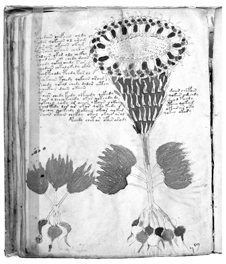
A plant illustration from the Voynich manuscript
BEINECKE RARE BOOK AND MANUSCRIPT LIBRARY, YALE UNIVERSITY
What attracted his attention even more than the text were the illustrations that appeared on almost every page—sometimes in the margins, sometimes in the body of the work. There were hundreds of them—exotic-looking plants, quaint astronomical and astrological symbols and charts, and, most bizarre, strings of tiny naked women cavorting in a variety of fountains, waterfalls, and pools. The work appeared to be some sort of encyclopedia of natural science, possibly for use in the practice of medicine. Examining the vellum pages, the calligraphy, the drawings, and the pigments used, Voynich, an expert medievalist, dated the manuscript as late thirteenth century. However, when he perused the odd cursive script itself, he realized that it wasn't Latin, or any other known language for that matter. He could make no sense at all of what was written. With some further examination, he discovered why—the entire manuscript was in cipher.

An example of Voynich script
BEINECKE RARE BOOK AND MANUSCRIPT LIBRARY, YALE UNIVERSITY

Detail from a Voynich manuscript page
BEINECKE RARE BOOK AND MANUSCRIPT LIBRARY, YALE UNIVERSITY
No thirteenth-century manuscript of this length and detail written in cipher had ever been found before, and Voynich knew that he had stumbled upon something of exceptional importance. The sense of intrigue fascinated him as well. The knowledge had evidently been meant to be hidden. But why? What was there in these drawings of bathing women and lush plants that posed a threat to the author or to the intended reader? Or had the author taken these precautions because he feared repercussions if his book fell into the wrong hands?
Wilfrid Voynich was no stranger to conspiracy. He had been born in Lithuania in 1865, the son of Polish aristocracy. He attended the universities of Warsaw and Moscow, where he fell in with the Russian anarchist Sergius Stepniak. Stepniak, who was subsequently arrested and imprisoned for attempting to assassinate the chief of the Russian secret police, eventually escaped and fled to England. Stepniak's anarchist movement had a great influence on Lenin's older brother Alexandr, who was caught in a similar plot to assassinate the tsar and was executed in 1888.
Voynich was himself arrested by the secret police in 1885 for plotting against the Russian domination of eastern Poland. Only twenty years old, he was placed in solitary confinement in a Warsaw jail cell so cold and cramped that he developed tuberculosis and became permanently disfigured, with one shoulder always held higher than the other. After a year he escaped, but he stayed on to fight to expel the Russians. He was wounded several times before being arrested again; this time he was sent to Siberia. “Here I have sword, here I have sword, here I have bullet,” he later told one of his rare book employees, pulling up his shirt and showing off his scars.
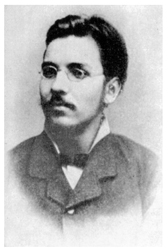
Wilfrid M. Voynich, ca. 1885
COURTESY RAFAL PRINKE
He escaped from Siberia as well, then, wanted and penniless, slipped across the continent and made it all the way to London, where he turned up on Stepniak's doorstep. According to the legend that grew up around him, Voynich borrowed a half crown from Stepniak and shortly thereafter appeared at the British Museum with a number of rare and unusual books that just happened to be among those that the museum was then seeking to acquire. The museum enthusiastically bought the books for an undisclosed sum, one sufficient to allow Voynich to set up shop as a rare book dealer. It also gave him the wherewithal to marry Stepniak's beautiful blond assistant, Ethel. Ethel was the youngest daughter of George Boole, the famous Cambridge professor of mathematics who developed a system of algebraic logic that is now considered one of the precursors of computer science.
(Ethel was no stranger to conspiracy either. After marrying Voynich, she carried on a long-running affair with the World War I master spy Sidney Reilly, whom she then used as the model for the protagonist in her novel
The Gadfly
, which sold over 2.5 million copies in translation and, because of its glamorous radical hero, became one of the most beloved novels in Soviet Russia.)
Soon, the immigrant Voynich, who spoke English in a series of malapropisms, became an established member of one of Britain's most exclusive and snobbiest clubs—antiquarian book dealers. In addition to his shop on Shaftesbury Avenue, Voynich opened branches in Paris, Florence, and Warsaw. He developed a clientele that included such famous collectors as Sir William Osler and the Earl of Crawford and Balcarres, but Voynich's visitors weren't all aristocrats and proper English gentlemen. A number of shady characters of murky Eastern European origin floated in and out of his shop. One time, a Polish woman who claimed to have been horribly persecuted by the Russians, barely escaping with her life, showed up in London, seeking to enter Voynich's circle. She didn't last long. When asked by one of his employees what had happened to her—Voynich was known to support these people in perpetuity—he replied coldly, “By mistake they sent me skunk.”
VOYNICH BROUGHT HIS UGLY DUCKLING MANUSCRIPT
back with him to London but did not put it up for sale. Instead, he sent photographed copies of some of the pages to about twenty of the most noted cryptographers in the world, including members of MI-8, the United States Army cryptographic unit.
At first it appeared that deciphering the manuscript would be easy. With so many plants and astronomical symbols encaptioned throughout, it was simply a matter of inquiring from botanists and astronomers what the actual names were and then plugging in plaintext equivalents into what was certainly a rudimentary alphabet-substitution code. One cryptologist predicted that the manuscript would be easier to decipher than a newspaper cryptogram.
It didn't seem to work, however. Many of the plant drawings, it turned out, had no counterparts in the real world, and those that did seem identifiable did not respond to alphabet substitution. The astronomical drawings were no more enlightening. In fact, the more the cryptologists looked, the more obscure the cipher became. For six years, the manuscript resisted all attempts to make any sense of it. Even the MI-8 team, which had enjoyed brilliant success against the best German military codes in World War I, made no progress. That a thirteenth-century manuscript could confound modern code breakers so thoroughly only made the challenge greater. The Voynich manuscript was fast becoming one of the world's most famous enigmas.
Then, in 1919, William Romaine Newbold, a distinguished professor of philosophy and dean of the graduate school at the University of Pennsylvania, announced a breakthrough. Newbold, an expert in philology and cryptanalysis, noticed that on the last page, the three lines of text were written in Latin and not the symbol alphabet of the remainder of the manuscript. Working with recognizable characters, he conducted an analysis revealing that those three lines were in a different cipher—part alphabet substitution, part anagram—that was more common and over the years had become familiar to medieval scholars. After Newbold decoded what he believed was the key—a set of “instructions” for decrypting the body of the text—a further examination of the page showed that someone else had done so as well. There was a faded, almost invisible notation in one of the margins giving exactly the same solution. It was dated 1630.
In the meantime, Voynich had set himself to uncover the provenance of his discovery, hoping by this route to come to the author. When he had first dated the cipher manuscript as thirteenth century and noticed from the drawings the breadth of subjects that it apparently covered, he had decided that only two men had the scientific expertise necessary to compose such a work. One was the German Albertus Magnus (Albert the Great). Renowned for his vast contributions to theology and science, he was called
Doctor Universalis
for his encyclopedic knowledge in every area of medieval scholarship and was especially known for his role in incorporating Greek learning into the academic curriculum. He was thirteenth-century Europe's most accomplished natural scientist. As great as Albertus Magnus's achievements, however, Voynich personally favored the second man, whom he considered an “infinitely greater scholar.”
